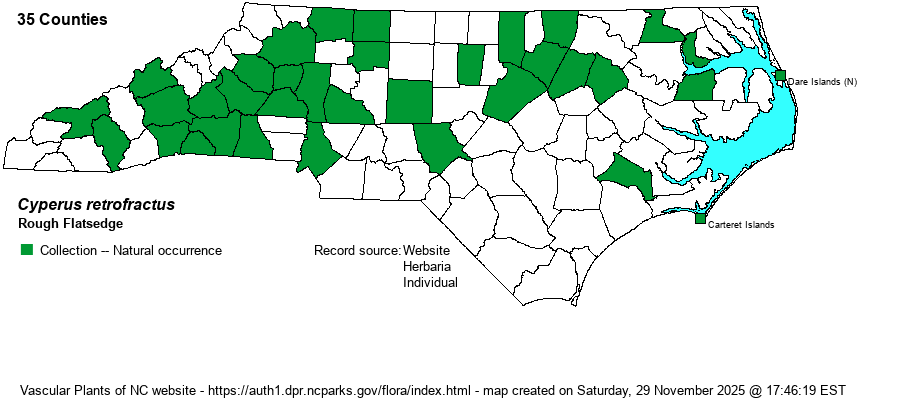| Author | (L.) Torrey | |
| Distribution | Mostly the southern Mountains and upper Piedmont, and scattered in the central and lower Piedmont and the northern Coastal Plain. Rare on the Outer Banks. Perhaps absent from the northern/higher Mountains.
NJ to OH and MO, south to GA, AL, and AR. | |
| Abundance | Infrequent to frequent in the Mountains and Piedmont; scarce in the Coastal Plain. Essentially absent from the southern Coastal Plain. | |
| Habitat | Dry sandy or rocky woodlands, clearings, fields, maritime forests. | |
| Phenology | Flowering and fruiting July-September. | |
| Identification | The wide-spreading inflorescence of Rough Flatsedge looks like a fireworks display. The 4-13 spikes are ob-cylindrical (widest at tip) and occur at the ends of very long stalks. It is similar to C. plukenetii, but the spikes are twice as long (or more). It is also similar to C. hystricinus, but differs in the rather scabrous (rough to touch) stems (vs. smooth). | |
| Taxonomic Comments | A synonym is C. dipsaciformis.
The genus Cyperus is mostly tropical and warm-temperate in distribution; thus, in NC it is much commoner in the Coastal Plain than in the Mountains and Piedmont. Most species have 1-few flowering stems (culms) from grasslike basal leaves, plus a few stem leaves. At the summit is an inflorescence of very open and branched, or tightly packed, spikes, varying among species from brown to golden brown to straw-color to reddish. The arrangement of the spikelets is important, whether like a hand (digitate) or in paired or alternate rows (pinnate); as is the shape of the achene (seed), whether bi-convex in cross-section or triangular. As a group, Cyperus tends to be weedy and readily enters disturbed ground; this is true for many natives as well as all the aliens. In recent years, following DNA research, the genus has incorporated several genera that in RAB (1968) or other manuals were separate: Hemicarpha, Lipocarpha, and Kyllinga. | |
| Other Common Name(s) | Teasel Flatsedge | |
| State Rank | S3 [S3S4] | |
| Global Rank | G5 | |
| State Status | | |
| US Status | | |
| USACE-agcp | FACU link |
| USACE-emp | UPL link |

